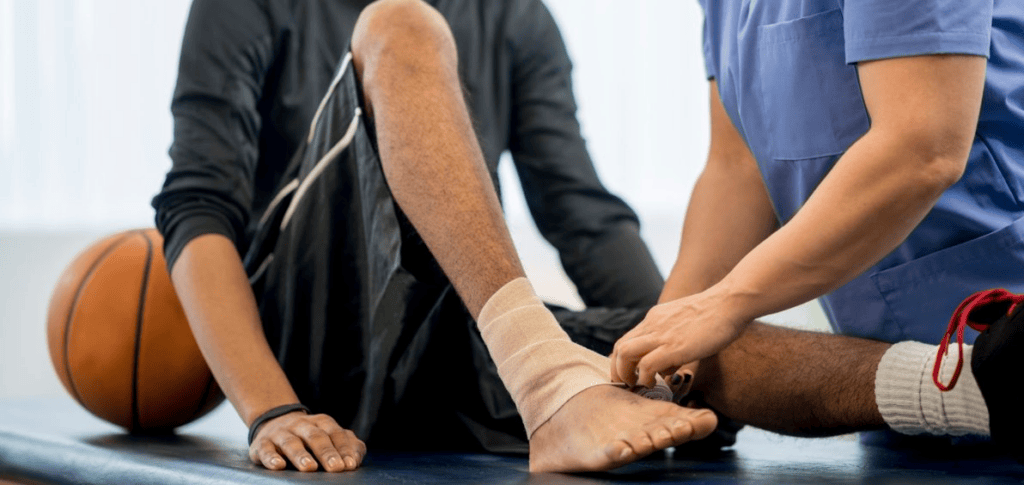Sports and physical activities are essential for maintaining health and fitness. Whether you’re a professional athlete or recreational player, managing pain and sports injuries is a difficult challenge. Every year, so many sports professionals & enthusiasts face the challenge of joint pain, muscle strain, disc bulge, tendonitis, and sprains which can threaten their ability to perform and enjoy their favourite activities. Engaging in sports like Football, basketball, soccer, tennis, or even trekking can put significant stress on our muscles, joints, and other body parts due to the sudden starts, stops, and directional changes involved. But here’s the thing: joint pain doesn’t have to be the new normal. Understanding the causes, prevention strategies, and treatment options for sports-related joint pain can be the key to returning to the game.
Tigris Valley Ayurvedic Wellness Resort, nestled in the serene landscapes of Kerala, India, is renowned as one of the best wellness retreats in India, offering holistic Ayurvedic treatments. The resort is a sanctuary for those seeking natural and effective for sports injuries treatment, sports rehabilitation, and post-surgical recovery.
At Tigris Valley, the approach to sports injury treatment is comprehensive, combining traditional Ayurvedic wisdom with modern medical practices. The resort boasts a team of specialized doctors and therapists who are experts in Ayurvedic sports medicine. These professionals provide personalized treatment plans tailored to the specific needs of each athlete, ensuring optimal recovery and long-term health

injuries can result from accidents, inadequate training, improper gear, or insufficient warm-up exercises.
Strains: Sprains involve the stretching or tearing of ligaments, the tissues that connect bones. They often occur in the ankles, knees, and wrists. Strains are injuries to muscles or tendons, the tissues that connect muscles to bones. They are common in the back, hamstrings, and shoulders.
Knee Injuries: Knee injuries are frequent in sports, especially those that involve running, jumping, and sudden changes in direction. Common knee injuries include:
Anterior Cruciate Ligament (ACL) Tears: Often caused by sudden stops or changes in direction.
Meniscus Tears: Resulting from twisting movements.
Patellar Tendonitis: Inflammation of the tendon connecting the kneecap to the shinbone.
Fractures: Fractures, or broken bones, are caused by a significant force impact. Common fractures in sports include:
Stress Fractures: Small cracks in the bone caused by repetitive force, often in the lower legs and feet.
Acute Fractures: Sudden breaks usually resulting from falls or direct blows.
Dislocations: A dislocation occurs when a bone is forced out of its normal position in a joint. The shoulder is the most commonly dislocated joint, but dislocations can also occur in the fingers, knees, and elbows.

Tendonitis: Tendonitis Is the inflammation of a tendon, often due to overuse. Common types include:
Achilles Tendonitis: Pain and inflammation in the tendon connecting the calf muscles to the heel bone, common in runners.
Rotator Cuff Tendonitis: Affects the shoulder, particularly in sports involving overhead motions like swimming or tennis.
Concussions: Concussions are traumatic brain injuries caused by a blow to the head or body that causes the brain to move rapidly within the skull. They are common in contact sports like football, rugby, and boxing.
Shin Splints: Shin splints refer to pain along the shinbone (tibia), often occurring in runners and athletes who suddenly increase their training intensity. It’s typically caused by overuse or improper footwear.
Tennis Elbow (Lateral Epicondylitis): This injury is caused by overuse of the forearm muscles, leading to inflammation of the tendons on the outside of the elbow. It’s common in tennis players but can affect anyone who performs repetitive arm movements.
Plantar Fasciitis: Plantar fasciitis involves inflammation of the plantar fascia, a thick band of tissue that runs across the bottom of the foot. It’s common in runners and athletes who engage in sports involving much running or jumping.
Hamstring Injuries: Hamstring injuries involve tears or strains in the muscles at the back of the thigh. They are common in sports that require sprinting, such as soccer, track, and football.

Athletes often experience joint pain due to the high physical activities including repetitive stress, overuse injuries, improper technique, and lack of adequate rest. High-impact sports and activities that involve frequent jumping, running, or sudden changes in direction can intensify these issues, leading to inflammation, wear, tear, and overall discomfort. Rehabilitation in sports injuries by Tigris Valley offers practical strategies to prevent joint injuries, including proper warm-up routines, strength training, and the importance of technique and recovery. Here’s why it happens and some ways to prevent it:
– Repeated stress on joints from frequent training
– Severe injuries such as sprains, strains, and fractures
– Poor form or technique during exercise
– Insufficient rest between workouts
– Muscle imbalances or weakness
– As athletes age, wear and tear on joints
The treatment process begins with a detailed assessment of the injury, followed by a customized therapy plan. The resort uses a blend of herbal medicines, therapeutic massages, and Panchakarma therapies to reduce inflammation, alleviate pain, and promote healing. Ayurvedic treatments like Kizhi (herbal poultice) and Abhyanga (therapeutic oil massage) are particularly effective in enhancing blood circulation, relaxing muscles, and restoring mobility.
For sports rehabilitation, Tigris Valley offers a structured program that focuses on strengthening the affected area, improving flexibility, and preventing future injuries. The rehabilitation process is supported by yoga and meditation sessions, which help in regaining physical strength and mental resilience.
In post-surgical treatment, the resort provides a nurturing environment for recovery. Ayurvedic therapies are designed to accelerate healing, reduce scar tissue formation, and restore the body’s natural balance. The serene surroundings and personalized care at Tigris Valley contribute significantly to the patient’s recovery, making it a preferred destination for holistic healing in India.
Tigris Valley Ayurvedic Wellness Resort stands out not just for its exceptional treatments but also for its commitment to nurturing the overall well-being of its guests, making it a haven for those on the path to recovery.







